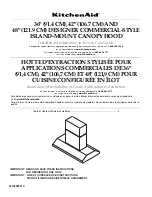
WARNING
R
angehood Fans
MODEL
OD-22014
PLEASE READ INSTRUCTION BEFORE COMMENCING INSTALLATION AND RETAIN FOR FUTURE REFERENCES.
Electrical products can cause death or injury, or damage to property.
If in any doubt about the installation or
use of this product, consult competent
technicians.
INSTALLATION GUIDE
WARNING — THE INSTALLATION MUST BE CARRIED OUT BY
A QUALIFIED
ELECTRICIAN.
1. Ducted fans MUST always be vented to the outdoors
2.
Rangehood fans
can only be installed by qualified
technician
s
3. Clean ventilation fans frequently. DO NOT allow grease to accumulate on the fan or the filter
4. Turn OFF power at the service panel before servicing, cleaning or replacing to a new rangehood fan
Instruction Manual
1-888-543-6473
1-888-541-6474
13376 Comber Way
Surrey BC V3W 5V9
[email protected]
www.ortechindustries.com
375 Admiral Blvd
Missis
s
auga
,
ON L5T 2N1
Application Notice
1.
NEVER pick a flaming pan
as you may be injured.
2.
Always turn the hood ON when cooking at high heat or when cooking flaming foods
3.
Use proper sized pans that correspond to the size of the stove and the amount of food being cooked
4.
DO NOT use water, including wet dish clothes or towels, to put out a fire. A violent steam explosion may result
5.
To avoid damage to motor or other components, keep drywall spray, construction dust, etc. off the power unit
6.
Smother flames with a close-fitting lid, metal tray or cookie sheet. Then turn OFF the burner.
Be careful to avoid burns! If the flames are not put out immediately, evacuate and call the fire department for help
7.
For general ventilation use only. DO NOT use this appliance to exhaust hazardous or explosive materials and vapours
8.
Before servicing or cleaning the unit, lock the service panel to prevent power from being switched on accidentally
9.
When cutting or drilling into wall or ceiling, be careful not to damage existing electrical wiring and other hidden utilities.
When the service disconnecting cannot be locked, securely fasten a prominent warning device, such as a tag, to the service panel
10.
Sufficient air is needed for proper exhausting of gases of fuel burning equipment through the flue (chimney) to prevent back drafting
11.
To reduce the risk of fire, use only metal ductwork. Please read specification label on product for further information and requirements
12.
DO NOT use any accessories not recommended by the manufacturer. This unit MUST be grounded and used only for its intended purpose
13.
Heat oils slowly on low or medium settings. Never leave cooking unattended at high settings. Boil-overs cause smoking and greasy spillovers that may ignite
14.
DO NOT use this appliance for commercial uses or with any solid-state speed control device. Installation work and electrical wiring MUST be done by qualified
technicians in accordance with all applicable codes and standards, including fire-rated construction
15. Use an extinguisher only if: a) The fire department is being called b) You can fight the fire with your back to an exit
c) The fire is small and contained in the area where it started d) You know that you have a Class ABC extinguisher and you already know how to use it
D
O NOT
CAUTION
CAUTION
CAUTION
Tools needed for installation
•
Drill
•
Pliers
•
Duct tape
•
Electrical tape
•
Connector clamp
•
Flat-head screwdriver
•
Phillips head screwdriver
•
1/8" drill bit for drilling pilot holes
•
1-1/4" wood bit for drilling electrical wiring access hole
•
Hand saw or jig saw for cutting the wall or cabinet openings
General Preparation
Installation procedure will require 2 people for easier installation.
Ensure to turn power OFF before beginning the installation:
1. Remove the rangehood from the carton
2. Lay the rangehood upside down on a table covered with either
cardboard or paper to prevent scratching the hood or table
3. Unscrew the lamp cover with a Phillips head screwdriver
4. Remove the lamp cover and install one 40W light bulb
Replace the lamp cover and the screws
Selecting the Venting Direction
The rangehood can be used for either horizontal, vertical or
ductless air discharge. For the best performance, use the shortest
possible ducting path and the least amount of elbows when
discharging horizontally or verrtically
Vertical Discharge
Vertical discharge is the most common method of hood installation.
If your kitchen has an attic space above, the ducting may be run
through the cupboard and the attic to a roof cap. Use a 7" round
duct (not included). Another option, if your kitchen has a soffit
above the cabinet, is to run the duct up into the soffit and then
discharge the air horizontally through the outside wall to a wall cap
Vertical Discharge Diagram






















